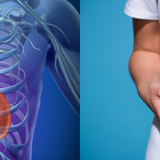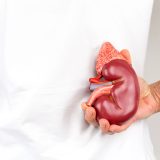If you are one of the estimated 26 million Americans with chronic kidney disease (CKD), maintaining the fluid balance in your body is crucial. This is because kidneys that are damaged by CKD are less capable of performing their very important role of fluid elimination. Unfortunately, the substance most frequently used to season or process food disrupts fluid balance and can wreak havoc on the body of someone with chronic kidney disease.
Salt
If you have ever witnessed a chef prepare food – or if cooking is your forte, then you know that great amounts of salt are relied on to season most foods. In addition to freshly cooked meals, many canned, processed or restaurant foods are also loaded with sodium (salt) to boost their flavor. Despite salt’s ability to make our taste buds sing, high sodium levels inevitably change the body’s fluid balance, which leads to swelling. This is because of osmosis, where water moves across a semi-permeable membrane from areas of lower concentration into a higher concentration to balance the fluid’s saltiness.
Kidneys and Salt
Since the kidneys regulate sodium levels, those with CKD must be extra vigilant about not exceeding their daily sodium limit. The following describes the kidneys’ relationship with sodium:
- When sodium levels in the body are low, kidneys conserve sodium.
- When sodium levels are high, the kidneys excrete the excess amount in urine.
- If one’s kidneys can’t eliminate enough sodium, the sodium starts to accumulate in the blood.
- Because sodium attracts and holds water (due to osmosis), blood volume increases.
- Increased blood volume makes the heart work harder to move more blood through the blood vessels, thus increasing blood pressure.
- High blood pressure can damage the kidneys.
Besides being prescribed for those with high blood pressure, low sodium diets are always advised for those with CKD to prevent worsening of their condition.
Revealing Salt’s Presence
Most clinicians agree that those with high blood pressure or CKD should consume less than 2,000 mg of sodium per day – even though most of us ingest more than twice that amount. The first step to restricting sodium intake is to identify where this common seasoning lurks. In general, foods that are canned, pickled, for snacking, condiments, sauces, dressings, soups, cured, salted or prepared frozen meals are all high in sodium. Maintaining a sodium intake below 2,000 mg per day requires considerable effort.
Below are several estimates to get you thinking about how much salt you might unknowingly ingest:
- One teaspoon of table salt contains about 2,300 mg of sodium.
- Three ounces of ham contains about 1, 114 mg of sodium.
- One tablespoon of soy sauce contains about 1,029 mg of sodium.
- One cup of vegetable juice cocktail contains about 653 mg of sodium.
- One cup of a prepared cheese sauce contains about 1,198 mg of sodium.
- One cup of low-fat cottage cheese contains about 918 mg of sodium.
- Ten hard, plain, salted pretzels contain about 1,029 mg of sodium.
- One cup of canned tomato sauce contains about 1,482 mg of sodium.
Going Low Sodium
One of the best ways to help your kidneys maintain proper fluid balance is by adhering to a low-sodium diet. Reading the label of your chosen food is the best way to keep track of how much salt you consume. For those new to going low sodium, keep the following five pointers in mind:
- Fresh herbs, spice blends without sodium, garlic, onions, lemon and flavored vinegar make tasty alternatives to seasoning food with salt.
- Although food may initially taste bland without added salt, the taste buds can be retrained in two to three weeks.
- When dining out, request your food be prepared without salt, have dressings or sauces on the side and avoid bacon bits, cheese and croutons at the salad bar.
- Do not use salt substitutes (especially those high in potassium*) unless a healthcare provider approves. *For those with CKD, potassium can be even more harmful than sodium.
- Avoid drinking softened water, because water softeners remove calcium and add sodium to drinking water.
In order to prevent high blood pressure, swelling and further kidney damage, a low sodium diet is critical. Consuming fewer than 2,000 mg of sodium per day benefits many parts of the body; however, the kidneys are especially grateful. So if you have CKD, high blood pressure, or are just dedicated to living healthfully, commit yourself to restricting sodium from your diet by reading labels and consciously choosing how your food is seasoned.




